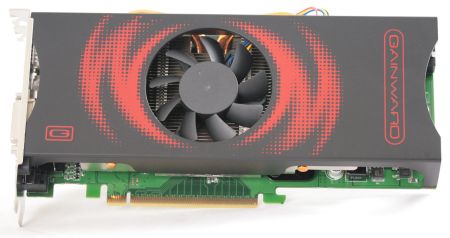Nvidia's GeForce 9600 GT Tested
Leadtek and Gainward Cards
The card models we tested are from Leadtek and Gainward. The Leadtek WinFast PX9600 GT Extreme uses the same design as the Nvidia reference card. On the outside, nothing sets it apart from the GeForce 8800 GT V2 - that is, the version that was equipped with the new, larger cooling fan. That fan is quieter under load; its size allows a significant reduction in rotation speed, providing a better air flow/noise ratio. It's a single-slot card with a PCB that is entirely covered by the cooling system housing, keeping hot air inside the case. Aside from the usual two connectors (PCI Express 6-pin power and SLI), there's a 2-pin connector, and the reference card comes with a small cable for connecting the 9600 GT to the internal S/PDIF connector on the motherboard or sound card (via 2 pins).
This version also comes with an active DVI->HDMI adapter, including audio. Nvidia is implicitly recognizing the soundness of the initiative AMD ushered in with its Radeon 2000, but without the same elegance. Lacking an audio controller, the GeForce 9600 GT needs to be connected to an external controller via this cable, meaning that it loses the motherboard/sound card's S/PDIF connector and system sounds (if you want to distinguish your Home Cinema/TV installation from your PC speakers).
The really good news about this 9600 GT, finally, is the presence of 512 MB of onboard memory, though 256 MB and 1 GB versions are probably in the works. The 256 MB on the GeForce 8800 GT 256 MB was that card's real limiting factor (despite its lower frequency than the 8800 GT's). The GeForces were penalized by too little memory, starting at 1280x1024 with antialiasing enabled and 1680x1050, even with PCI Express 2.0 (which our motherboard uses).
Despite the reference design, the Leadtek model justifies the "Extreme" in its name because of its factory overclocking, with the GPU clocked at 720 MHz (1750 MHz for the stream processors) compared to the reference 650 MHz (and 1625 MHz); the memory remains at 900 MHz. It's tempting to draw the conclusion that all models will be able to be clocked to those frequencies...
To provide a wider range of outputs, Gainward's Bliss 9600 GT Golden Sample is two slots wide. The outputs are very nice: two DVI-Is as on the Leadtek, but also an HDMI, a DisplayPort, digital coaxial, and finally a grille for venting some of the hot air out of the case! Gainward took advantage of the extra real estate to build in a dual-slot heat sink using two heatpipes and an axial fan (for a better speed/noise ratio) with a PWM connector. This card's frequencies have also been boosted, to 700 MHz for the GPU and 1000 MHz for the memory. The extra cost compared to the basic version (also offered by Gainward) is 20 €, which seems fairly reasonable.
Get Tom's Hardware's best news and in-depth reviews, straight to your inbox.
-
tijmen007 Nice Review, was really helpfull chosing between the HD4670 and 9600GT. Cause the HD4670 is a bit slower as the HD3850 due its memory bus of 128-bit.Reply
Tijmen -
Unicorns_FTW Wow, it is amazing how much AA & AF deplete your FPS on games such as Crysis and COD 4. I have a Palit 9600GT along with a E8400, and it more or less matches these benchies. Great review once again.Reply -
silicondoc Thanks for the review - helps in putting together medium range systems. Card prices have gone up now ( Feb 2009 ) after they went down during and about "black Friday" time.Reply
I see the lowest priced 9600GT at $90, %65 after rebate, with free Far Cry 2.
Not bad at all.
-
ceponatia 9600GT is a POS. It has wonderful performance, as the review stated, until it crashes to a black screen. I have had two different cards and they both do the same thing. Buy a Radeon.Reply

